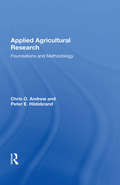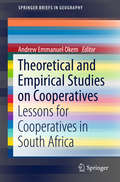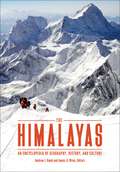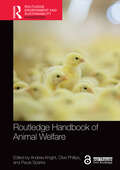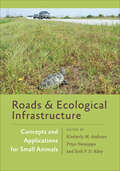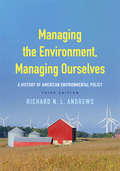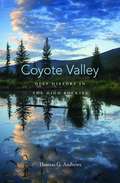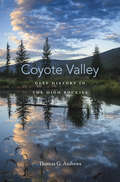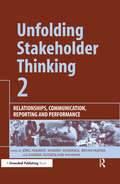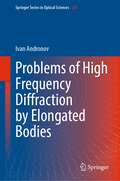- Table View
- List View
Applied Agricultural Research: Foundations And Methodology
by Chris O AndrewThe desire to resolve problems through pragmatic observation, systematic evaluation, and coordinated action persists with each new generation of researchers. A timeless task that bears individual, social, and often cultural characteristics, problem resolution is essentially an experiential process. Routine and methodology can enhance both its proce
Theoretical and Empirical Studies on Cooperatives: Lessons for Cooperatives in South Africa (SpringerBriefs in Geography)
by Andrew Emmanuel Emmanuel OkemThe book outlines how cooperatives can be used as a tool for development and reconciliation in post-conflict contexts. This book also examines the successes and challenges for emerging and existing cooperatives in Africa, while delivering both practical lessons and insights into the theory. It presents completely new materials on the cooperative movement, against a backdrop of increasing global recognition of the roles of cooperatives and collective action in socio-economic development. Readers are invited to consider how, as an economic model that seeks to advance member collective interests, cooperatives are invaluable tools for human, economic and social development. Social and human geographers find this a remarkably impactful contribution to the literature surrounding cooperatives in Africa and cooperative theory in general. Policy experts and students also find the research informative and insightful.
The Himalayas: An Encyclopedia of Geography, History, and Culture
by Andrew J. Hund and James A. WrenA thorough and detailed resource that describes the history, culture, and geography of the Himalayan region, providing an indispensable reference work to both general readers and seasoned scholars in the field.The Himalayas: An Encyclopedia of Geography, History, and Culture serves as a convenient and authoritative reference for anyone exploring the region and seeking to better understand the history, events, peoples, and geopolitical details of this unique area of the world. It explores the geography and details of the demographics, discusses relevant historical events, and addresses socioeconomic movements, political intrigues and controversies, and cultural details as to give an overarching impression of the region as a coherent and cohesive whole. Readers will come away with a vastly heightened understanding of the geographical region we recognize as the Himalayas, and grasp the issues of geography, history, and culture that are central to contemporary understandings of the human culture in the region.The alphabetically arranged and succinct entries provide easy access to detailed, authoritative information. Additionally, sidebars throughout the book relate compelling facts that point readers to new and interesting avenues of exploration. The volume also includes a chronological overview of the region, ten primary source documents, and a comprehensive bibliography of supporting works.
International Perspectives on Teaching and Learning with GIS in Secondary Schools
by Andrew J. J. Milson, Ali Demirci and Joseph J. J. KerskiThis, the first publication to collate a broad international perspective on the pedagogical value of GIS technology in classrooms, offers an unprecedented range of expert views on the subject. Geographic Information Systems (GISs) are now ubiquitous and relatively inexpensive. They have revolutionized the way people explore and understand the world around them. The capability they confer allows us to capture, manage, analyze, and display geographic data in ways that were undreamt of a generation ago. GIS has enabled users to make decisions and solve problems as diverse as designing bus routes, locating new businesses, responding to emergencies, and researching climate change. GIS is also having a major impact in the classroom. Students and teachers around the world are using this significant emerging technology in the secondary school classroom to study social and scientific concepts and processes, to broaden their technical skills, and to engage in problem solving and decision making about local and global issues.International Perspectives on Teaching and Learning with GIS in Secondary Schools brings together authors from 34 countries who profile the current status of GIS in secondary school teaching and learning in their country. Each chapter includes a summary of the country’s educational context, a case study illustrating how GIS is used in secondary schooling, and an assessment of the opportunities and challenges in teaching and learning with GIS now and in the future. The book demonstrates that GIS is not only a technological tool to be used in the classroom, but also a catalyst for motivation, encouragement, and cooperation in understanding and solving global problems.The most up to date and extensive survey of GIS in the secondary education landscape, covering both principles and practice.Professor David Maguire, Pro-Vice-Chancellor, Birmingham City University, UKInternational Perspectives on Teaching and Learning With GIS in Secondary Schools is a highly relevant, critically important, reflective contribution to the literature, providing strong arguments supporting the inclusion for spatial studies for all in secondary school education. Karl Donert, President, EUROGEOThis is an invaluable and inspirational examination of innovation in geospatial technologies in secondary schools around the world. Each chapter contains practical models for how to integrate powerful tools for spatial analysis into a range of subjects. It will be useful to classroom teachers and administrators seeking pathways to implementation and teacher educators considering how to prepare the next generation to use geospatial technologies.Sarah Witham Bednarz, Department of Geography, Texas A&M University, College Station, TX, USA
Routledge Handbook of Animal Welfare (Routledge Environment and Sustainability Handbooks)
by Andrew Knight, Clive Phillips, and Paula SparksThis handbook presents a much-needed and comprehensive exploration of the rapidly growing fields of animal welfare and law. In recent years there has been increasing attention paid to our complex, multifaceted relationships with other animals, and in particular, the depth and breadth of various societal uses of animals. This has led to a reconsideration of their moral and social status, which has sometimes challenged the interests of those who use animals. In such a contested domain, sound evidence and reasoning become particularly important. Through firm commitment to such principles, this book explores the biological foundations for the moral consideration of animals and for evolving conceptualisations of animal welfare. It reviews in detail the welfare concerns associated with numerous forms of animal use. The inclusion of key recent developments such as climate change, pandemics, and antimicrobial resistance, ensures this text is among the most current in its field. The ethical implications of the various uses of animals by society are considered, and chapters provide important recommendations for reforms of practice, law, or policy. The status of animal law internationally, and in major world regions, is reviewed. Finally, the book considers human behavioural change and strategies for improving stakeholder communication and education. The handbook is essential reading for students and scholars of animal welfare, animal law and animal ethics everywhere, and for policy-makers and other professionals working in the animal welfare sector.
Ecology and Recovery of Eastern Old-Growth Forests
by Andrew M. Barton and William S. KeetonThe landscapes of North America, including eastern forests, have been shaped by humans for millennia, through fire, agriculture, hunting, and other means. But the arrival of Europeans on America’s eastern shores several centuries ago ushered in the rapid conversion of forests and woodlands to other land uses. By the twentieth century, it appeared that old-growth forests in the eastern United States were gone, replaced by cities, farms, transportation networks, and second-growth forests. Since that time, however, numerous remnants of eastern old growth have been discovered, meticulously mapped, and studied. Many of these ancient stands retain surprisingly robust complexity and vigor, and forest ecologists are eager to develop strategies for their restoration and for nurturing additional stands of old growth that will foster biological diversity, reduce impacts of climate change, and serve as benchmarks for how natural systems operate. Forest ecologists William Keeton and Andrew Barton bring together a volume that breaks new ground in our understanding of ecological systems and their importance for forest resilience in an age of rapid environmental change. This edited volume covers a broad geographic canvas, from eastern Canada and the Upper Great Lakes states to the deep South. It looks at a wide diversity of ecosystems, including spruce-fir, northern deciduous, southern Appalachian deciduous, southern swamp hardwoods, and longleaf pine. Chapters authored by leading old-growth experts examine topics of contemporary forest ecology including forest structure and dynamics, below-ground soil processes, biological diversity, differences between historical and modern forests, carbon and climate change mitigation, management of old growth, and more. This thoughtful treatise broadly communicates important new discoveries to scientists, land managers, and students and breathes fresh life into the hope for sensible, effective management of old-growth stands in eastern forests.
COVID-19 and Similar Futures: Pandemic Geographies (Global Perspectives on Health Geography)
by Gavin J. Andrews Valorie A. Crooks Jamie R. Pearce Jane P. MessinaThis volume provides a critical response to the COVID-19 pandemic showcasing the full range of issues and perspectives that the discipline of geography can expose and bring to the table, not only to this specific event, but to others like it that might occur in future. Comprised of almost 60 short (2500 word) easy to read chapters, the collection provides numerous theoretical, empirical and methodological entry points to understanding the ways in which space, place and other geographical phenomenon are implicated in the crisis. Although falling under a health geography book series, the book explores the centrality and importance of a full range of biological, material, social, cultural, economic, urban, rural and other geographies. Hence the book bridges fields of study and sub-disciplines that are often regarded as separate worlds, demonstrating the potential for future collaboration and cross-disciplinary inquiry. Indeed book articulates a diverse but ultimately fulsome and multiscalar geographical approach to the major health challenge of our time, bringing different types of scholarship together with common purpose. The intended audience ranges from senior undergraduate students and graduate students to professional academics in geography and a host of related disciplines. These scholars might be interested in COVID-19 specifically or in the book’s broad disciplinary approach to infectious disease more generally. The book will also be helpful to policy-makers at various levels in formulating responses, and to general readers interested in learning about the COVID-19 crisis.
Ageing and Place (Routledge Studies in Human Geography)
by Gavin J. Andrews David R. PhillipsDuring recent years, an increasing amount of academic research has focused on older people with a particular emphasis on settings, places and spaces. This book provides a comprehensive review of research and the policy area of 'ageing and place'. An insightful book on an important topic, Andrews and Phillips have together edited a valuable information and reference source for those with interests in the spatial dimensions of ageing in the twenty-first century. Ranging from macro-scale perspectives on the distribution of older populations on national scales, to the meaning of specific local places and settings to older individuals, on the micro-scale, the book spans an entire range of research traditions and international perspectives.
Ageing and Place (Routledge Studies in Human Geography)
by Gavin J. Andrews David R. PhillipsDuring recent years, an increasing amount of academic research has focused on older people with a particular emphasis on settings, places and spaces. This book provides a comprehensive review of research and the policy area of 'ageing and place'. An insightful book on an important topic, Andrews and Phillips have together edited a valuable information and reference source for those with interests in the spatial dimensions of ageing in the twenty-first century. Ranging from macro-scale perspectives on the distribution of older populations on national scales, to the meaning of specific local places and settings to older individuals, on the micro-scale, the book spans an entire range of research traditions and international perspectives.
Roads and Ecological Infrastructure: Concepts and Applications for Small Animals (Wildlife Management and Conservation)
by Kimberly M. Andrews Priya Nanjappa Seth P. RileyFew of us think twice about driving on roads. Yet the very presence of roads and the act of driving on them can impact the ecological infrastructure that supports an animal’s daily life. What chance does a turtle have of successfully laying its eggs when it needs to traverse a busy highway? Is it realistic to expect small mammals to breed when an interstate thoroughfare subdivides their population? These are the sorts of challenges faced by small, often slow-moving, animals, challenges that road engineers and ecologists are trying to address.For countless small species, vehicles traveling at high speeds are nothing less than missiles shooting across migration pathways. For too many animals, the danger can lead to the loss of populations, in part because they simply are not programmed to react to traffic. Salamanders faced with a two-lane road between the forest and their aquatic breeding site, for example, will typically cross that road regardless of the congestion. The result can be hundreds of flattened animals in a single night.Roads and Ecological Infrastructure is the first book to focus on reducing conflict between roads and small animals. Highlighting habitat connections and the challenges and solutions from both transportation and ecological perspectives, the volume covers various themes, including animal behavior related to roads and design approaches to mitigate the negative effects of roads on wildlife. The chapter authorsâ€�from transportation experts to university researchersâ€�each promote a goal of realistic problem solving. Conceptual and practical, this book will influence the next decade or more of road design in ecologically sensitive areas and should prevent countless unnecessary wildlife fatalities.
Managing the Environment, Managing Ourselves: A History of American Environmental Policy
by Richard N. AndrewsIn the third edition of this definitive book, Richard N. L. Andrews looks back at four centuries of American environmental policy, showing how these policies affect contemporary environmental issues and public policy decisions, and identifying key policy challenges for the future. Andrews crafts a detailed and contextualized narrative of the historical development of American environmental policies and institutions. This volume presents an extensively revised text, with increased detail on the 50-year history of the modern environmental policy era and updated through the Obama and Trump administrations.
Light and Waves: A Conceptual Exploration of Physics
by Steven S. AndrewsThis book explores light and other types of waves, using this as a window into other aspects of physics. It emphasizes a conceptual understanding, using examples chosen from everyday life and the natural environment. For example, it explains how hummingbird feathers create shimmering colors, how musical instruments produce sound, and how atoms stick together to form molecules. It provides a unique perspective on physics by emphasizing commonalities among different types of waves, including string waves, water waves, sound waves, light waves, the matter waves of quantum mechanics, and the gravitational waves of general relativity. This book is targeted toward college non-science majors, advanced high school students, and adults who are curious about our physical world. It assumes familiarity with algebra but no further mathematics and is classroom-ready with many worked examples, exercises, exploratory puzzles, and appendices to support students from a variety of backgrounds.
Coyote Valley: Deep History in the High Rockies
by Thomas G. AndrewsThomas Andrews drills deep into the many pressures that have reshaped a small stretch of North America, from the ice age to the advent of the Anthropocene and controversies over climate change. He brings to the surface lessons about the critical relationships to land, climate, and species that only seemingly unimportant places on Earth can teach.
Coyote Valley: Deep History in the High Rockies
by Thomas G. AndrewsThomas Andrews drills deep into the many pressures that have reshaped a small stretch of North America, from the ice age to the advent of the Anthropocene and controversies over climate change. He brings to the surface lessons about the critical relationships to land, climate, and species that only seemingly unimportant places on Earth can teach.
The Superdeep Well of the Kola Peninsula (Exploration of the Deep Continental Crust)
by N. I. Andrianov M. I. Vorozhbitov D. M. Guberman V. I. Kazansky E. W. Karus V. S. Lanev E. B. Nalivkina R. A. SumbatovThe present book is devoted to the study of the deep Earth's interior structure, one of the most important problems of Earth sciences today. The drilling of the Kola superdeep well inaugurated a new stage in the study of the Precambrian continental crust. The well was sunk in the northeastern part of the Baltic Shield, in an area where the Precambrian ore-bearing structures, typical of the ancient platform basements, are in juxtaposition with each other. To the present the well has been drilled to a depth of 12 km, has traversed the full thickness of the Proterozoic complex and a considerable part of the Archean stratum, and is still be ing worked on. This book reviews the principal results of investigations to a depth of 11,600 m; these are described in three sections: geology, geophysics, and drilling. The book begins with a general review of the history, the present state of knowledge, and trends of further investigations in the field of study of the Earth's interior and superdeep drilling. The first section of the book considers the geology of the vicinity of the Kola superdeep well and describes its geological section based on a detailed examination both of the cores and the near-borehole area.
Seismic Love Waves
by Z. S. AndrianovaAmong seismic waves generated by widely dilferent types of sources, the waves that are the most interest ing and of the longest duration are usually surface waves (which are also called normal waves, interference and channel waves, natural vibrations of layers, etc. ). These waves are distinguished by their dispersion and reso nance, and are used in many investigations - in the determination of the structure of the medium (the existence of surface layers and waveguides), in the determination of the coordinates and properties of the source (in par ticular its energy and mechanism), in the identification of subterranean exploSions, in the mapping of micro-· seisms, in the tracing of storms, etc. Outlines of the wide literature concerning surface waves can be found in [2, 9, 40J. Surface waves can be classed as Rayleigh or Love waves, depending on their velocity and polarization: the displacements of particles in Rayleigh waves are parallel, and the displacements in Love waves perpendicular, to the vertical plane containing the direction of propagation (some variation from this polarization is possible close to the source or in the presence of horizontal inhomogeneities in the medium). The present work is devoted to the calculation and investigation of Love waves in a vertically layered medium. The method used is based on the spectral theory of linear differential operators. ' This method is much more effective than previously applied methods based on the approximation of the medium by a set of homogeneous layers.
Visual Analytics of Movement
by Gennady Andrienko Natalia Andrienko Peter Bak Daniel Keim Stefan WrobelMany important planning decisions in society and business depend on proper knowledge and a correct understanding of movement, be it in transportation, logistics, biology, or the life sciences. Today the widespread use of mobile phones and technologies like GPS and RFID provides an immense amount of data on location and movement. What is needed are new methods of visualization and algorithmic data analysis that are tightly integrated and complement each other to allow end-users and analysts to extract useful knowledge from these extremely large data volumes.This is exactly the topic of this book. As the authors show, modern visual analytics techniques are ready to tackle the enormous challenges brought about by movement data, and the technology and software needed to exploit them are available today.The authors start by illustrating the different kinds of data available to describe movement, from individual trajectories of single objects to multiple trajectories of many objects, and then proceed to detail a conceptual framework, which provides the basis for a fundamental understanding of movement data. With this basis, they move on to more practical and technical aspects, focusing on how to transform movement data to make it more useful, and on the infrastructure necessary for performing visual analytics in practice. In so doing they demonstrate that visual analytics of movement data can yield exciting insights into the behavior of moving persons and objects, but can also lead to an understanding of the events that transpire when things move. Throughout the book, they use sample applications from various domains and illustrate the examples with graphical depictions of both the interactive displays and the analysis results. In summary, readers will benefit from this detailed description of the state of the art in visual analytics in various ways. Researchers will appreciate the scientific precision involved, software technologists will find essential information on algorithms and systems, and practitioners will profit from readily accessible examples with detailed illustrations for practical purposes.
Exploratory Analysis of Spatial and Temporal Data: A Systematic Approach
by Natalia Andrienko Gennady AndrienkoExploratory data analysis (EDA) is about detecting and describing patterns, trends, and relations in data, motivated by certain purposes of investigation. As something relevant is detected in data, new questions arise, causing specific parts to be viewed in more detail. So EDA has a significant appeal: it involves hypothesis generation rather than mere hypothesis testing. The authors describe in detail and systemize approaches, techniques, and methods for exploring spatial and temporal data in particular. They start by developing a general view of data structures and characteristics and then build on top of this a general task typology, distinguishing between elementary and synoptic tasks. This typology is then applied to the description of existing approaches and technologies, resulting not just in recommendations for choosing methods but in a set of generic procedures for data exploration. Professionals practicing analysis will profit from tested solutions – illustrated in many examples – for reuse in the catalogue of techniques presented. Students and researchers will appreciate the detailed description and classification of exploration techniques, which are not limited to spatial data only. In addition, the general principles and approaches described will be useful for designers of new methods for EDA.
Unfolding Stakeholder Thinking 2: Relationships, Communication, Reporting and Performance
by Jörg Andriof Sandra Waddock Bryan Husted Sandra Sutherland RahmanThis book is the companion to "Unfolding Stakeholder Thinking: Theory, Responsibility and Engagement", which examined many emerging theoretical and normative issues and was released to acclaim in October 2002. "Unfolding Stakeholder Thinking 2" collects a series of essays by leading researchers worldwide to focus on the practice of stakeholder engagement in terms of relationship management, communication, reporting and performance. As stakeholder relationships and business in society have become increasingly central to the unfolding of stakeholder thinking, important new topics have begun to take centre stage in both the worlds of practice and academia. The first part of the book makes clear that simply engaging with stakeholders is insufficient to build successful stakeholder strategies. Companies, considered as the focal entity in a relationship, also need to actively communicate with stakeholders and manage their relationships. Dialogue is essential but can only be useful if companies listen to the messages that stakeholders are sending them. It is also essential to understand the role of power and influence in stakeholder engagement strategies especially if partnerships or collaborations emerge from the relationships that are engendered. The book examines a wide range of corporate–NGO collaborations to determine what makes them effective – and what makes them fail. Conflict management in stakeholder alliances is also discussed. The second part of the book addresses the critically important element of emerging schemes for the assessment, measurement and reporting of business in society and relationships involving stakeholders. A variety of current approaches to stakeholder assessment and reporting are discussed here including social auditing and sustainability reporting. The evolution of stakeholder thinking has led to a new view of the firm as an organism embedded in a complex web of relationships with other organisms. The role of management becomes immensely more challenging, when stakeholders are no longer seen as simply the objects of managerial action but rather as subjects with their own objectives and purposes. This book captures the complexity of managing relationships with stakeholders and will provide both practitioners and researchers with a wealth of information on the benefits and consequences of this practice.
Unfolding Stakeholder Thinking 2: Relationships, Communication, Reporting and Performance
by Jörg Andriof Sandra Waddock Bryan Husted Sandra Sutherland RahmanThis book is the companion to "Unfolding Stakeholder Thinking: Theory, Responsibility and Engagement", which examined many emerging theoretical and normative issues and was released to acclaim in October 2002. "Unfolding Stakeholder Thinking 2" collects a series of essays by leading researchers worldwide to focus on the practice of stakeholder engagement in terms of relationship management, communication, reporting and performance. As stakeholder relationships and business in society have become increasingly central to the unfolding of stakeholder thinking, important new topics have begun to take centre stage in both the worlds of practice and academia. The first part of the book makes clear that simply engaging with stakeholders is insufficient to build successful stakeholder strategies. Companies, considered as the focal entity in a relationship, also need to actively communicate with stakeholders and manage their relationships. Dialogue is essential but can only be useful if companies listen to the messages that stakeholders are sending them. It is also essential to understand the role of power and influence in stakeholder engagement strategies especially if partnerships or collaborations emerge from the relationships that are engendered. The book examines a wide range of corporate–NGO collaborations to determine what makes them effective – and what makes them fail. Conflict management in stakeholder alliances is also discussed. The second part of the book addresses the critically important element of emerging schemes for the assessment, measurement and reporting of business in society and relationships involving stakeholders. A variety of current approaches to stakeholder assessment and reporting are discussed here including social auditing and sustainability reporting. The evolution of stakeholder thinking has led to a new view of the firm as an organism embedded in a complex web of relationships with other organisms. The role of management becomes immensely more challenging, when stakeholders are no longer seen as simply the objects of managerial action but rather as subjects with their own objectives and purposes. This book captures the complexity of managing relationships with stakeholders and will provide both practitioners and researchers with a wealth of information on the benefits and consequences of this practice.
Remote Sensing of Clouds and Precipitation (Springer Remote Sensing/Photogrammetry)
by Constantin AndronacheThis book presents current applications of remote sensing techniques for clouds and precipitation for the benefit of students, educators, and scientists. It covers ground-based systems such as weather radars and spaceborne instruments on satellites. Measurements and modeling of precipitation are at the core of weather forecasting, and long-term observations of the cloud system are vital to improving atmospheric models and climate projections. The first section of the book focuses on the use of ground-based weather radars to observe and measure precipitation and to detect and forecast storms, thunderstorms, and tornadoes. It also discusses the observation of clouds using ground-based millimeter radar. The second part of the book concentrates on spaceborne remote sensing of clouds and precipitation. It includes cases from the Tropical Rainfall Measuring Mission (TRMM) and the Global Precipitation Measurement (GPM) mission, using satellite radars to observe precipitation systems. Then, the focus is on global cloud observations from the ClaudSat, Cloud-Aerosol Lidar and Infrared Pathfinder Satellite Observation (CALIPSO), including a perspective on the Earth Clouds, Aerosols, and Radiation Explorer (EarthCARE) satellite. It also addresses global atmospheric water vapor profiling for clear and cloudy conditions using microwave observations. The final part of this volume provides a perspective into advances in cloud modeling using remote sensing observations.
Problems of High Frequency Diffraction by Elongated Bodies (Springer Series in Optical Sciences #243)
by Ivan AndronovClassical asymptotic expansions, while producing a good approximation for the diffracted fields in general, appear hardly applicable in the case of extremely elongated bodies. Thus, there are problems that are on the one hand too difficult for numerical solvers due to large system size, and on the other hand make the description with classical asymptotic methods hard. The book explains why this happens and suggests the way out. By defining the characteristics of a strongly elongated body it introduces a special class of asymptotic approximations, which are in some sense uniform with respect to the rate of body elongation. Chapter 1 briefly describes the results of V. A. Fock and further developments of his approach towards the problems of diffraction by elongated obstacles. It formulates the cases of moderately and strongly elongated bodies. The rest of the book describes the approach of special parabolic equations, which lead to new asymptotic approximations for the diffracted fields. Chapters 2, 3 and 4 discuss diffraction by bodies of elliptical shape: The elliptic cylinder with a strongly elongated cross section and prolate spheroid with a high aspect ratio. Chapter 5 generalizes the approach to some other shapes such as narrow cones and narrow hyperboloids. Mathematical formulas for the Whittaker functions widely used in the book are collected in the Appendix. The concise derivations are supplied with numerous test examples that compare asymptotic approximations with numerically computed fields and clarify the specifics of high frequency diffraction by strongly elongated bodies. The reference solutions presented in the book enable one to validate the newly developed numerical solvers.
Die paleozäne Biohermenzone und das Verhältnis des Palaeogens zur Oberkreide in der pieninischen Klippenzone der Westkarpaten (Sitzungsberichte der Österreichischen Akademie der Wissenschaften)
by Dimitrij AndrusovPolitics, Statistics and Weather Forecasting, 1840-1910: Taming the Weather (Routledge Studies in the History of Science, Technology and Medicine)
by Aitor AnduagaWeather forecasting is the most visible branch of meteorology and has its modern roots in the nineteenth century when scientists redefined meteorology in the way weather forecasts were made, developing maps of isobars, or lines of equal atmospheric pressure, as the main forecasting tool. This book is the history of how weather forecasting was moulded and modelled by the processes of nation-state building and statistics in the Western world.
Politics, Statistics and Weather Forecasting, 1840-1910: Taming the Weather (Routledge Studies in the History of Science, Technology and Medicine)
by Aitor AnduagaWeather forecasting is the most visible branch of meteorology and has its modern roots in the nineteenth century when scientists redefined meteorology in the way weather forecasts were made, developing maps of isobars, or lines of equal atmospheric pressure, as the main forecasting tool. This book is the history of how weather forecasting was moulded and modelled by the processes of nation-state building and statistics in the Western world.
